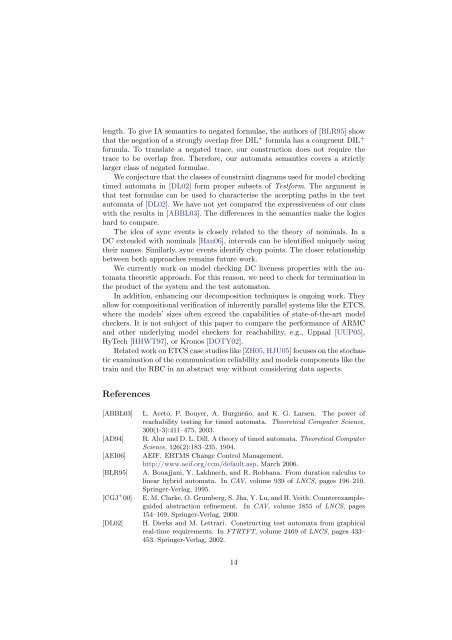Model Checking Duration Calculus - UNU-IIST
Model Checking Duration Calculus - UNU-IIST
Model Checking Duration Calculus - UNU-IIST
You also want an ePaper? Increase the reach of your titles
YUMPU automatically turns print PDFs into web optimized ePapers that Google loves.
length. To give IA semantics to negated formulae, the authors of [BLR95] showthat the negation of a strongly overlap free DIL + formula has a congruent DIL +formula. To translate a negated trace, our construction does not require thetrace to be overlap free. Therefore, our automata semantics covers a strictlylarger class of negated formulae.We conjecture that the classes of constraint diagrams used for model checkingtimed automata in [DL02] form proper subsets of Testform. The argument isthat test formulae can be used to characterise the accepting paths in the testautomata of [DL02]. We have not yet compared the expressiveness of our classwith the results in [ABBL03]. The differences in the semantics make the logicshard to compare.The idea of sync events is closely related to the theory of nominals. In aDC extended with nominals [Han06], intervals can be identified uniquely usingtheir names. Similarly, sync events identify chop points. The closer relationshipbetween both approaches remains future work.We currently work on model checking DC liveness properties with the automatatheoretic approach. For this reason, we need to check for termination inthe product of the system and the test automaton.In addition, enhancing our decomposition techniques is ongoing work. Theyallow for compositional verification of inherently parallel systems like the ETCS,where the models’ sizes often exceed the capabilities of state-of-the-art modelcheckers. It is not subject of this paper to compare the performance of ARMCand other underlying model checkers for reachability, e.g., Uppaal [UUP05],HyTech [HHWT97], or Kronos [DOTY02].Related work on ETCS case studies like [ZH05, HJU05] focuses on the stochasticexamination of the communication reliability and models components like thetrain and the RBC in an abstract way without considering data aspects.References[ABBL03][AD94][AEI06][BLR95][CGJ + 00][DL02]L. Aceto, P. Bouyer, A. Burgueño, and K. G. Larsen. The power ofreachability testing for timed automata. Theoretical Computer Science,300(1-3):411–475, 2003.R. Alur and D. L. Dill. A theory of timed automata. Theoretical ComputerScience, 126(2):183–235, 1994.AEIF. ERTMS Change Control Management.http://www.aeif.org/ccm/default.asp, March 2006.A. Bouajjani, Y. Lakhnech, and R. Robbana. From duration calculus tolinear hybrid automata. In CAV, volume 939 of LNCS, pages 196–210.Springer-Verlag, 1995.E. M. Clarke, O. Grumberg, S. Jha, Y. Lu, and H. Veith. Counterexampleguidedabstraction refinement. In CAV, volume 1855 of LNCS, pages154–169. Springer-Verlag, 2000.H. Dierks and M. Lettrari. Constructing test automata from graphicalreal-time requirements. In FTRTFT, volume 2469 of LNCS, pages 433–453. Springer-Verlag, 2002.14
















